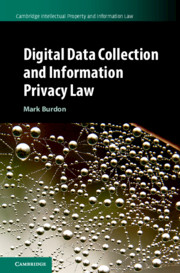Book contents
- Digital Data Collection and Information Privacy Law
- Cambridge Intellectual Property and Information Law
- Digital Data Collection and Information Privacy Law
- Copyright page
- Dedication
- Contents
- Figure and Tables
- Acknowledgements
- 1 Introduction
- Part I The Collected World
- Part II Information Privacy Law’s Concepts and Application
- 5 What Information Privacy Protects
- 6 How Information Privacy Law Protects
- Part III Information Privacy Law for a Collected Future
- Bibliography
- Index
- Cambridge Intellectual Property and Information Law
6 - How Information Privacy Law Protects
from Part II - Information Privacy Law’s Concepts and Application
Published online by Cambridge University Press: 04 April 2020
- Digital Data Collection and Information Privacy Law
- Cambridge Intellectual Property and Information Law
- Digital Data Collection and Information Privacy Law
- Copyright page
- Dedication
- Contents
- Figure and Tables
- Acknowledgements
- 1 Introduction
- Part I The Collected World
- Part II Information Privacy Law’s Concepts and Application
- 5 What Information Privacy Protects
- 6 How Information Privacy Law Protects
- Part III Information Privacy Law for a Collected Future
- Bibliography
- Index
- Cambridge Intellectual Property and Information Law
Summary
Chapter 6 investigates the different foundational structures and jurisdictional perspectives of information privacy law that involve EU, US and Australian legal frameworks. A historical perspective of information privacy law developments in each jurisdiction is provided based on three founding legal instruments for each jurisdiction. Historical development is important because it highlights that, although different jurisdictional laws are based on the same principled approach, different jurisdictions adopt different emphases. Two particularly emphases are examined: the type of regulated information that triggers regulatory response, namely, personally identifiable information in the US, and personal data in the EU and personal information in Australia. Information privacy law’s principled process of protection is also examined. Attention is given to collection principles as a means of outlining foundational differences between sectoral and comprehensive regimes of information privacy, particularly regarding the overt use of a notice and consent model.
Keywords
- Type
- Chapter
- Information
- Digital Data Collection and Information Privacy Law , pp. 140 - 184Publisher: Cambridge University PressPrint publication year: 2020



